My visit was right at dusk and I left just as much of the visiting crowd was still arriving. It is a twisty dark road for 25 miles to get to the Spruce Tree Ruins site, and there were ice patches in spots that don't get any winter sun. But the traffic arriving for this special event was heavy and the parking area full.
Trails in Mesa Verde National Park and Ute Mountain Tribal Park near Cortez, Colorado. Inludes Cliff Palace, Balcony House, Spruce Tree House, Eagle's Nest House and other Ancestral Pueblo Ruins. Trail Notes and Pictures. Hike for fitness and environmental awareness.
Friday, December 19, 2008
Luminarias at Spruce Tree House
A Luminaria is a small lantern made with a lighted candle supported inside an open brown paper bag with a layer of sand. During the holiday season displays of Luminarias are popular in Arizona and New Mexico and other areas of the southwest.
 The small lights are spaced at about ten feet along both sides of side walks and roads and create an enchanting evening display.
The small lights are spaced at about ten feet along both sides of side walks and roads and create an enchanting evening display.
 Mesa Verde National Park in southwest Colorado has an annual event where the route leading to the popular Spruce Tree House ruin is lined with Luminairas and the interiors and plazas of the ruin structures are lighted with camping lanterns. This is a popular event, especially with photographers. Tripods crowd the best vantage points both on the canyon rim and below.
Mesa Verde National Park in southwest Colorado has an annual event where the route leading to the popular Spruce Tree House ruin is lined with Luminairas and the interiors and plazas of the ruin structures are lighted with camping lanterns. This is a popular event, especially with photographers. Tripods crowd the best vantage points both on the canyon rim and below.
 In winter, there are normally three tours of Spruce Tree House per day, but another four are added for this special event. As dusk settles, the flickering Luminarias guide visitors down the switch back trail that descends into the ruin site. Walk carefully, it's still very dark with only candles to guide the way.
In winter, there are normally three tours of Spruce Tree House per day, but another four are added for this special event. As dusk settles, the flickering Luminarias guide visitors down the switch back trail that descends into the ruin site. Walk carefully, it's still very dark with only candles to guide the way.
 One of the problems that Ancestral Pueblo People would have had living in these cliff dweller sites is keeping warm in the winter. These rooms may have had small fires burning such that the effect may have been something like this. There are soot marks on the rock ceilings that some think indicate fires burning 24 hours a day.
One of the problems that Ancestral Pueblo People would have had living in these cliff dweller sites is keeping warm in the winter. These rooms may have had small fires burning such that the effect may have been something like this. There are soot marks on the rock ceilings that some think indicate fires burning 24 hours a day.
My visit was right at dusk and I left just as much of the visiting crowd was still arriving. It is a twisty dark road for 25 miles to get to the Spruce Tree Ruins site, and there were ice patches in spots that don't get any winter sun. But the traffic arriving for this special event was heavy and the parking area full.
My visit was right at dusk and I left just as much of the visiting crowd was still arriving. It is a twisty dark road for 25 miles to get to the Spruce Tree Ruins site, and there were ice patches in spots that don't get any winter sun. But the traffic arriving for this special event was heavy and the parking area full.
Monday, December 8, 2008
Balcony House Trail
Balcony House is one of the three cliff dwellings at Mesa Verde National Park in southwest Colorado where you have to buy a $3 dollar ticket for a ranger led one hour tour. The trail head is on the Cliff Palace Loop in the Chapin Mesa area.
The other two guided hikes are the famous Cliff Palace and the nearly equally large Long House. Balcony House is one of the most popular sites for visitors to Mesa Verde.
 Everyone says that Balcony House is the Indiana Jones adventure tour. To get into the ruin you have to walk down 130 steps to get to a point below the ruin, perched high on a steep canyon wall. There was not an original entrance to the Balcony House site from this side. It was installed by the Park Service to make the visit easy.
Everyone says that Balcony House is the Indiana Jones adventure tour. To get into the ruin you have to walk down 130 steps to get to a point below the ruin, perched high on a steep canyon wall. There was not an original entrance to the Balcony House site from this side. It was installed by the Park Service to make the visit easy.  Then you have to climb a 32 foot ladder to arrive at a narrow entry, slither along a sandstone wall, then ducking through a low opening, to arrive in a small plaza. This village is thought to have been home to about 40 people 700 years ago, then mysteriously abandoned.
Then you have to climb a 32 foot ladder to arrive at a narrow entry, slither along a sandstone wall, then ducking through a low opening, to arrive in a small plaza. This village is thought to have been home to about 40 people 700 years ago, then mysteriously abandoned.
 I had thought it had the name Balcony House because it was perched like a balcony with a low wall, hanging over a deep canyon. The low wall is called a parapet wall and is a unique feature, probably important for keeping children from falling into the canyon below.
I had thought it had the name Balcony House because it was perched like a balcony with a low wall, hanging over a deep canyon. The low wall is called a parapet wall and is a unique feature, probably important for keeping children from falling into the canyon below.
 But actually, it has this name because one of the second floor rooms has a small ledge outside the window, a feature not often preserved as well as here, but seen in other large sites.
But actually, it has this name because one of the second floor rooms has a small ledge outside the window, a feature not often preserved as well as here, but seen in other large sites.
 There are two large circular ceremonial kivas on the south side of the site. This medium sized site appears to have about 28 rooms besides the two kivas. The south side may have been the business side of the site and children were kept more to the north side plaza with the protective parapet wall. The back of the site has two springs. This was a fortunate site to have water so handy.
There are two large circular ceremonial kivas on the south side of the site. This medium sized site appears to have about 28 rooms besides the two kivas. The south side may have been the business side of the site and children were kept more to the north side plaza with the protective parapet wall. The back of the site has two springs. This was a fortunate site to have water so handy.
 The ruin is small compared to some of the other ones, but the adventure continues. To get out of the site you have to crawl on hands and knees through 12 feet of tunnel, then climb another ladder, and scramble up some primitive steps carved into stone, while clinging to a chain hand hold. The only place to view Balcony House besides the tour is from the Soda Canyon Trail where there is an across the canyon overlook.
The ruin is small compared to some of the other ones, but the adventure continues. To get out of the site you have to crawl on hands and knees through 12 feet of tunnel, then climb another ladder, and scramble up some primitive steps carved into stone, while clinging to a chain hand hold. The only place to view Balcony House besides the tour is from the Soda Canyon Trail where there is an across the canyon overlook.
The other two guided hikes are the famous Cliff Palace and the nearly equally large Long House. Balcony House is one of the most popular sites for visitors to Mesa Verde.
Sunday, September 14, 2008
Petroglyph Trail-Interpretation
The 2.4 mile Petroglyph Trail in Mesa Verde National Park in southwest Colorado is probably the best all around hiking trail in the park that can be visited every year.
The Petroglyph Trail itself visits the rocky, sheltered, and forested area just below the rim of Spruce Canyon, passes by a small ruins site and goes past the best petroglyph site in Mesa Verde. But before you get to that, the interpretive descent into the canyon identifies many of the common plants of the canyon and passes by Spruce Tree House, one of two cliff dweller sites that can be visited without going on a ranger guided tour.
The trail has a lot of ups and downs, rocky steps and wide canyon views before arriving at the highlight petroglyph panel. The trail guide offers some interpretations that were provided by current day Hopi Native Americans.
The squarish swirl below the hand print represents the "Sipapu" the place where the Pueblo People emerged from the earth, taken as the Grand Canyon in northern Arizona. To the left of the Sipapu and higher the Eagle Clan symbol indicates that they separated from the main migration group. To the left of the Eagle, the Mountain Sheep Clan also dropped away from the migration.
The human figures represent the people and the "whipping Kachinas" influencing the people. The "whipping Kachinas" are spirits who "straightened out" the people and gave direction to their travels. I imagine we could all benefit from "whipping Kachinas." In current Hopi religion the San Francisco Peaks near Flagstaff, Arizona are the home of the Kachinas, the spirits who bring the rain so that the corn will grow. Corn was the most important crop of these people and still plays an important spiritual role.
The swirl to the right has two interpretations. It represents the either the end of the migration, here in Mesa Verde, or the future end in the modern Hopi Villages in Arizona. To the left of the swirl is a lizard symbol, meaning either that the Horned Toad clan separated off from the migration, or the Lizard Spirit had influence, causing a period of wandering without direction. The human figure to the left of the lizard is another "whipping Kachina."
To the left of the "whipping Kachina" is either the Mountain Lion Clan symbol, or an all powerful animal spirit watching over the people in their travels. These interpretations cover about half of the figures that are here. There are several hand prints, and other animal and human figures and a lot of swirled lines.
After the petroglyph panel the trail climbs to the canyon rim and returns loops back toward the Spruce Tree House area, giving some views from above and to the side.
After the petroglyph panel the trail climbs to the canyon rim and returns loops back toward the Spruce Tree House area, giving some views from above and to the side.
Sunday, July 27, 2008
Pool Canyon Trail - Nordenskiold Sites in Ute Mountain Tribal Park
The Pool Canyon Trail is in a rarely visited part of Ute Mountain Tribal Park, which sits on the south side of Mesa Verde National Park in southwest Colorado. This hike is only offered one or two times per year and is a guided hike.
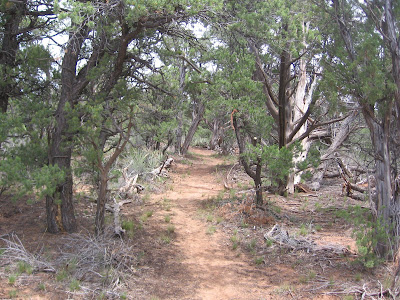 The access to the trail is along the Mesa Top Tour loop south of the Chapin Mesa Museum Area. The hike is about a three mile round trip and visits three cliff dweller ruins sites in Pool Canyon. The first part of the hike traverses a fairly lush area of Pinon Pine and Juniper Forest then descends to the head of Pool Canyon.
The access to the trail is along the Mesa Top Tour loop south of the Chapin Mesa Museum Area. The hike is about a three mile round trip and visits three cliff dweller ruins sites in Pool Canyon. The first part of the hike traverses a fairly lush area of Pinon Pine and Juniper Forest then descends to the head of Pool Canyon.

Often in these structures, different styles of masonry are seen side by side, indicating that the site was worked on over a period of years, or perhaps by different crews of workers. These sites were all abandoned around 1300 with the people migrating to areas to the south. Drought is often suggested as the reason, but some say it was just time to move on.
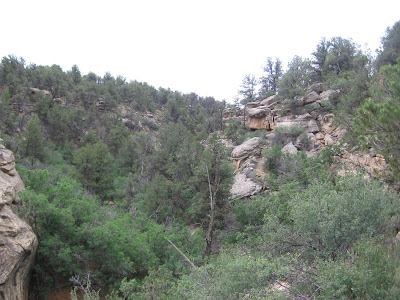 Pool Canyon isn't as deep as many of the canyons in the Mesa Verde area and the rock alcoves are not as high. It is thought that the Ancestral Pueblo people spent most of their time on the mesa top in farming activity and only a fraction of time in these cliff dweller sites.
Pool Canyon isn't as deep as many of the canyons in the Mesa Verde area and the rock alcoves are not as high. It is thought that the Ancestral Pueblo people spent most of their time on the mesa top in farming activity and only a fraction of time in these cliff dweller sites.
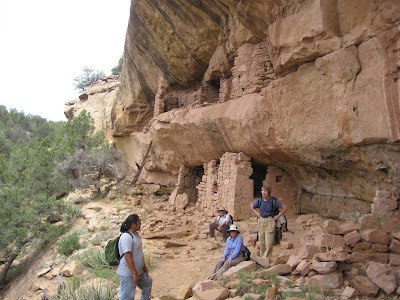
The forest in the canyon is mostly Pinon Pine and Gambel Oak. Utah Juniper is also common in the area. The rooms here and at the other sites in Pool Canyon are small and not very tall due to the shape of the alcoves. Some of the doorways use the key hole style that is seen at other sites around the region. I noticed that one of the rooms used larger than average stones on the lowest course. There are two sites in Mesa Verde where this is noted, referred to as megalithic stones.
The upper level stone work appeared to be in good condition. There is a log leaning here that has the look of a primitive ladder but no one attempted to climb up there. The black streaks on the sandstone are deposits of manganese and are sometimes called desert varnish.
 The third ruins site on the Pool Canyon Trail is the Nordenskiold No. 3 site. This appeared to be the largest of the three sites, with a wide alcove but not a very tall one. There are some upper level structures at this site.
The third ruins site on the Pool Canyon Trail is the Nordenskiold No. 3 site. This appeared to be the largest of the three sites, with a wide alcove but not a very tall one. There are some upper level structures at this site.
Peeking in through some of the openings, there are two and in some cases three small rooms before the back of the alcove. This sandstone rock alcove site is wider than the other two sites on this trail but like them, there isn't much room overhead in these structures.
The No. 3 site is deep in the back and is a shady and cool site on a hot summer day. This site shows double thick walls which usually means it was later in the period of occupation. Also, there are some keyhole style doorways which I always think are clever. Some the sandstone from the overhead area has crashed down onto the site. These large slabs are not seen at the Mesa Verde National Park sites, presumably they have been cleared away for visitor convenience. The Ute Mountain Park has mostly left nature to its own.
The No. 3 site is in a sort of pocket off the main canyon. It looks like that during a heavy rain storm, water from above would pour off in a sheet right in front of the main room blocks. The rooms would be protected by being back inside far enough. There is a fairly deep hole in front of the site that appears to have been gouged by falling drainage from above. it must have been an entertaining spectacle here during a heavy storm.
It was a 45 minute hike back to the trail head from the No.3 site. Our group spent about 4:15 hours on the trail and visiting the sites.
The first ruin site is the Nordenskiold No. 5 site. Nordenskiold was a Swedish scientist who was the first professional to view the Mesa Verde sites in 1891. The sites in Ute Mountain Tribal Park haven't been worked on very much or stabilized and are in the condition they were found in, except that many of the artifacts were removed in the early 1900s.
This site seems to have had some of the sandstone from the overhead alcove collapse on the front. The overhead crashing down is not something you usually think about when visiting these sites, but there must have been some accumulated debris when the sites were first occupied that made readily available building material. There are some small structures on a second level up to the left of the main site. These small rooms are thought to be storage areas.
Often in these structures, different styles of masonry are seen side by side, indicating that the site was worked on over a period of years, or perhaps by different crews of workers. These sites were all abandoned around 1300 with the people migrating to areas to the south. Drought is often suggested as the reason, but some say it was just time to move on.
The second ruins site visited is the Nordenskiold No. 4 site. This is a two level site with neither level very tall due to the nature of the alcove. This site was on the opposite side of the Pool Canyon from the No. 5 site. The trail here follows along the bottom of the canyon, much of it in the dry creek bed. Just before this site there are a few petroglyphs scratched into the sandstone walls.
The forest in the canyon is mostly Pinon Pine and Gambel Oak. Utah Juniper is also common in the area. The rooms here and at the other sites in Pool Canyon are small and not very tall due to the shape of the alcoves. Some of the doorways use the key hole style that is seen at other sites around the region. I noticed that one of the rooms used larger than average stones on the lowest course. There are two sites in Mesa Verde where this is noted, referred to as megalithic stones.
The upper level stone work appeared to be in good condition. There is a log leaning here that has the look of a primitive ladder but no one attempted to climb up there. The black streaks on the sandstone are deposits of manganese and are sometimes called desert varnish.
Peeking in through some of the openings, there are two and in some cases three small rooms before the back of the alcove. This sandstone rock alcove site is wider than the other two sites on this trail but like them, there isn't much room overhead in these structures.
The No. 3 site is deep in the back and is a shady and cool site on a hot summer day. This site shows double thick walls which usually means it was later in the period of occupation. Also, there are some keyhole style doorways which I always think are clever. Some the sandstone from the overhead area has crashed down onto the site. These large slabs are not seen at the Mesa Verde National Park sites, presumably they have been cleared away for visitor convenience. The Ute Mountain Park has mostly left nature to its own.
The No. 3 site is in a sort of pocket off the main canyon. It looks like that during a heavy rain storm, water from above would pour off in a sheet right in front of the main room blocks. The rooms would be protected by being back inside far enough. There is a fairly deep hole in front of the site that appears to have been gouged by falling drainage from above. it must have been an entertaining spectacle here during a heavy storm.
It was a 45 minute hike back to the trail head from the No.3 site. Our group spent about 4:15 hours on the trail and visiting the sites.
Sunday, July 13, 2008
Kodak House Overlook Trail
The Kodak House Trail is a short paved walk to an overlook on Wetherill Mesa in Mesa Verde National Park in southwest Colorado.
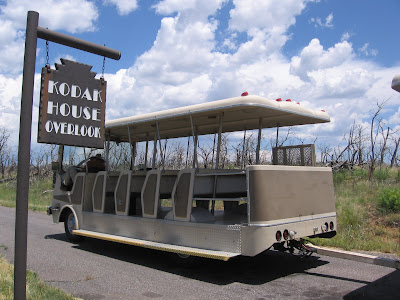 The trail head is reached by riding the Wetherill Mesa tram. It is one of two overlooks, along with the Long House overlook, that can only be reached by riding the tram.
The trail head is reached by riding the Wetherill Mesa tram. It is one of two overlooks, along with the Long House overlook, that can only be reached by riding the tram.
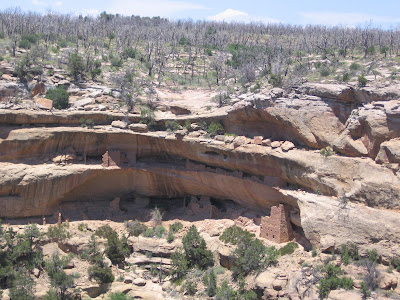 Kodak House received its name from the camera that was stored in one of the rooms by early investigator Gustaf Nordenskiold. When he first examined the site it had already been severely damaged by pot hunters.
Kodak House received its name from the camera that was stored in one of the rooms by early investigator Gustaf Nordenskiold. When he first examined the site it had already been severely damaged by pot hunters.
 Kodak House sits just below the rim of a large wide canyon. The site has a two level structure and about 70 rooms and 6 or 7 kivas.
Kodak House sits just below the rim of a large wide canyon. The site has a two level structure and about 70 rooms and 6 or 7 kivas.
Tuesday, July 8, 2008
Nordenskiold No. 16 Ruin Trail
The Nordenskiold No. 16 Ruin Trail is a 1.0 mile round trip to an overlook of the alcove protected structures. It is an additional 0.5 miles walking to the trailhead from the tram parking area on Wetherill Mesa in Mesa Verde National Park in southwest Colorado.
There is a good trail guide for this route, with numbered stops, that describes in detail the surrounding Pinon Pine and Juniper forest, and many of the plants and their ethnobotanical uses by the Ancestral Pueblo and the wildlife.
Unfortunately, much of this area was burned over during the 2000 Pony forest fire. Stop No. 3 on the guide describes how such fires help maintain a healthy and vigorous forest.
The Wetherills were ranchers from nearby Mancos, CO who had first stumbled onto the sites while rounding up stray cattle, or so it is said. Another version has it that the local Ute Indian Chief led the Wetherills to the sites.
Nordenskiold didn't spend much time at this site as it didn't have the artifacts he was interested in. He later took nine crates of material back to Europe with him.
This brazen act outraged other pot hunters and led to the passage of the 1906 Antiquities Act so that no one would get away with this again, at least not a European. The nine crates of treasures are now on display in the National Museum of Finland in Helsinki.
Wednesday, June 18, 2008
Mancos Canyon Tour-Kiva Point Trail
The Kiva Point Trail in Ute Mountain Tribal Park, in southwest Colorado is a short route just off the gravel road in the Mancos River Canyon near the Highway 491 entrance to the park.
Kiva Point is part of the regular tours at Ute Mountain. Both the half day and full day tours normally stop here. The Sun Calendar Tour in late May also stops here.
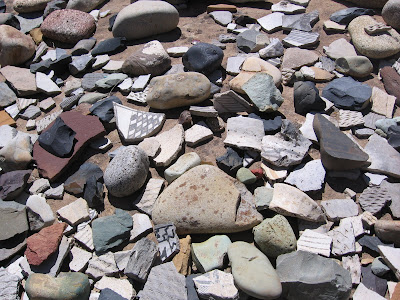 Ute Mountain Tribal Park requires all visitors to be escorted by a guide and one of the benefits of this system, as opposed to the mass system at nearby Mesa Verde, is the numerous collections of pottery shards and artifacts that are on display in the areas where they were found.
Ute Mountain Tribal Park requires all visitors to be escorted by a guide and one of the benefits of this system, as opposed to the mass system at nearby Mesa Verde, is the numerous collections of pottery shards and artifacts that are on display in the areas where they were found.
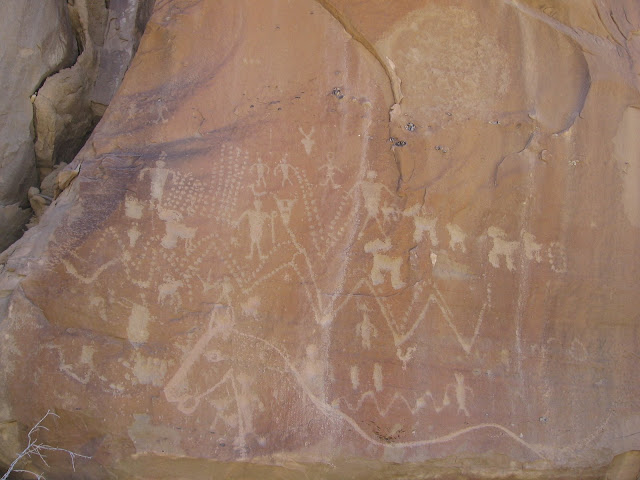
Among the highlights of this trail are the several panels of rock art petroglyphs on the sandstone cliffs a short climb from the road.
The interpretation of these drawings is usually a mystery though current day Pueblo People often have some insights.
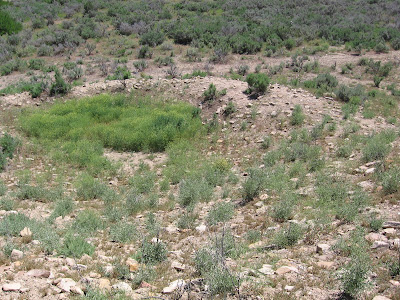 The Kiva here is unexcavated and appears as a large circle with scattered rubble. This site was a fairly large village area not far from the Mancos River, a modest sized stream that flows out of the nearby LaPlata mountains. There is an identified dancing ground near the site, along with collapsed towers and a possible three story pueblo.
The Kiva here is unexcavated and appears as a large circle with scattered rubble. This site was a fairly large village area not far from the Mancos River, a modest sized stream that flows out of the nearby LaPlata mountains. There is an identified dancing ground near the site, along with collapsed towers and a possible three story pueblo.
Kiva Point is part of the regular tours at Ute Mountain. Both the half day and full day tours normally stop here. The Sun Calendar Tour in late May also stops here.
Among the highlights of this trail are the several panels of rock art petroglyphs on the sandstone cliffs a short climb from the road.
The interpretation of these drawings is usually a mystery though current day Pueblo People often have some insights.
Tuesday, June 10, 2008
Eagle's Nest House on the Lion Canyon Trail
The highlight site on the Lion Canyon Trail in Ute Mountain Tribal Park in southwest Colorado is the spectacular Eagle's Nest House. It is the fourth of four cliff dweller sites along the three mile trail.
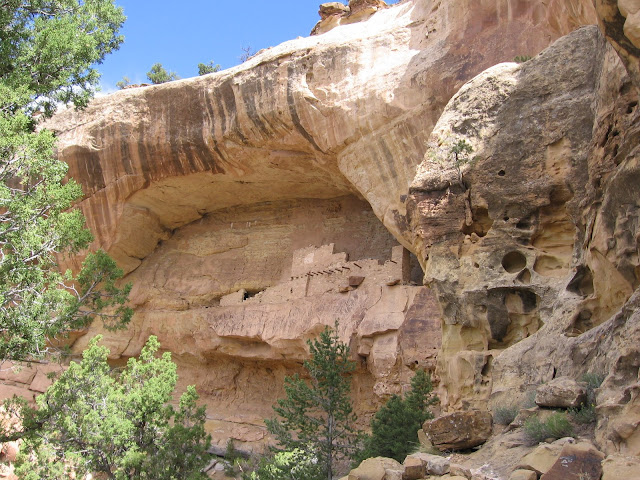 Eagles Nest is thought to be a 15 room and 1 kiva site. The exciting part of visiting this site is getting to it.
Eagles Nest is thought to be a 15 room and 1 kiva site. The exciting part of visiting this site is getting to it.
The trailhead is reached after a 40 minute ride on gravel roads. Then, a climb down three ladders into Lion Canyon, and hike 1.5 miles along a rough trail.
 The first challenge is to climb the 30 foot ladder. The guide made a point of saying that this climb was optional. Six of our group of eight made the harrowing climb.
The first challenge is to climb the 30 foot ladder. The guide made a point of saying that this climb was optional. Six of our group of eight made the harrowing climb.
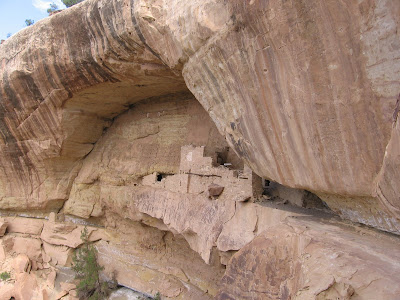 After reaching the top, there is a fairly narrow and low ceiling ledge to travel. I kept as far to the right as I could, ducking low and not looking over the edge.
After reaching the top, there is a fairly narrow and low ceiling ledge to travel. I kept as far to the right as I could, ducking low and not looking over the edge.
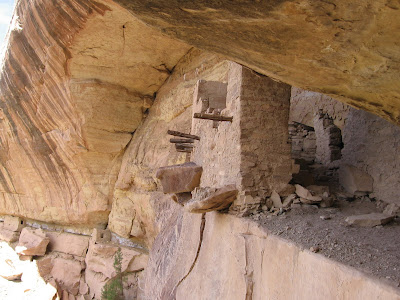 The posts sticking out horizontally of the structure probably supported a small balcony, similar to Balcony House in Mesa Verde. It's hard to imagine anyone sitting on the balcony, dangling their legs over the deep canyon.
The posts sticking out horizontally of the structure probably supported a small balcony, similar to Balcony House in Mesa Verde. It's hard to imagine anyone sitting on the balcony, dangling their legs over the deep canyon.
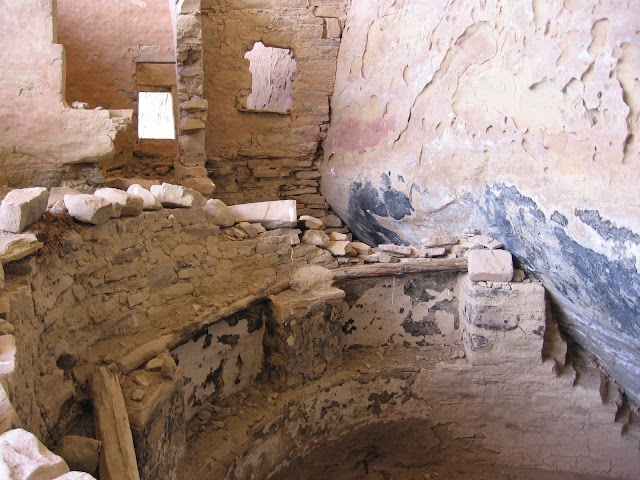 Creeping slowly and deeper into the site, we could peer into the circular kiva, some of its structures still intact after 700 years. We could creep further and look through the openings past the kiva. Then backtrack along the narrow ledge and the long ladder, to the relative safety of the primitive trail.
Creeping slowly and deeper into the site, we could peer into the circular kiva, some of its structures still intact after 700 years. We could creep further and look through the openings past the kiva. Then backtrack along the narrow ledge and the long ladder, to the relative safety of the primitive trail.
The trailhead is reached after a 40 minute ride on gravel roads. Then, a climb down three ladders into Lion Canyon, and hike 1.5 miles along a rough trail.
Sunday, June 8, 2008
Morris #5 Ruin on Lion Canyon Trail
The Morris #5 site is the third of the cliff dweller sites on the remote Lion Canyon Trail in Ute Mountain Tribal Park in southwest Colorado. The trail is a three mile round trip to four barely touched Ancestral Pueblo Ruins sites.
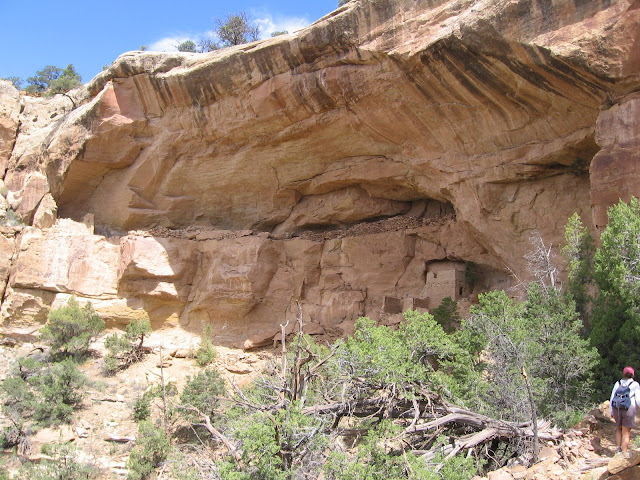 After riding 40 minutes on gravel roads through the Mancos River Canyon and climbing down several ladders we arrive at this 25 room and 2 kiva site.
After riding 40 minutes on gravel roads through the Mancos River Canyon and climbing down several ladders we arrive at this 25 room and 2 kiva site.
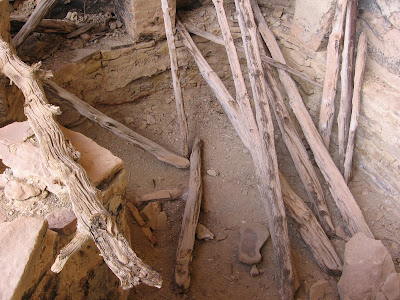 Archaeologist Morris found this ceremonial kiva with the roof still in place, a rare finding. But he also found a rare design inside. Lacking photo flash in the early 1900s he tore the roof off the photograph the design.
Archaeologist Morris found this ceremonial kiva with the roof still in place, a rare finding. But he also found a rare design inside. Lacking photo flash in the early 1900s he tore the roof off the photograph the design.
 The grooves in the sandstone here were described by the guide as a place where spears were sharpened. These details, along with the numerous collections of pottery and stone tools at the sites here in Ute Mountain Park are things that aren't seen very often in nearby Mesa Verde.
The grooves in the sandstone here were described by the guide as a place where spears were sharpened. These details, along with the numerous collections of pottery and stone tools at the sites here in Ute Mountain Park are things that aren't seen very often in nearby Mesa Verde.
 On a second level there seems to be a wall constructed without mortar. The guide suggested that this was thought to be an area for defense. Reachable only by a ladder, residents could retreat and toss the loose stones on unwanted visitors.
On a second level there seems to be a wall constructed without mortar. The guide suggested that this was thought to be an area for defense. Reachable only by a ladder, residents could retreat and toss the loose stones on unwanted visitors.
Saturday, June 7, 2008
Lion House on the Lion Canyon Trail
Lion House is the second cliff dweller site to see along the Lion Canyon Trail in Ute Mountain Tribal Park in southwest Colorado, sometimes called the "Other Mesa Verde."
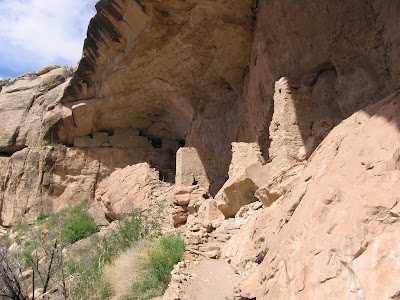 Lion House received its name for a family of mountain lions living here when the site was first investigated. The site is thought to have had 45 rooms and 7 kivas, the circular underground ceremonial rooms.
Lion House received its name for a family of mountain lions living here when the site was first investigated. The site is thought to have had 45 rooms and 7 kivas, the circular underground ceremonial rooms.
The Lion House site originally had some unusual D shaped kivas, though these were hard to see, and also had an area that was thought to be a day care area for children.
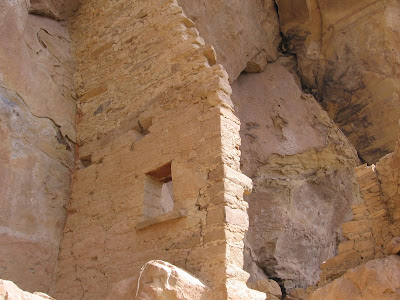 One section of wall shows two different building styles, indicating that it was built at different time periods.
One section of wall shows two different building styles, indicating that it was built at different time periods.
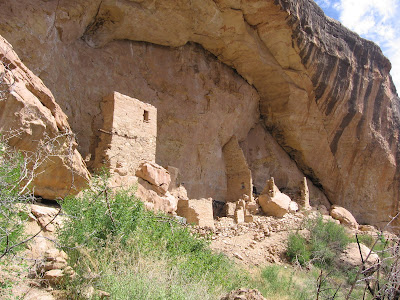 From the Lion House site the trail continues on to the generically named Morris #5 site. The total Lion Canyon Trail round trip is three miles and our group of eight spent 2:30 exploring this lightly visited area.
From the Lion House site the trail continues on to the generically named Morris #5 site. The total Lion Canyon Trail round trip is three miles and our group of eight spent 2:30 exploring this lightly visited area.
The Lion House site originally had some unusual D shaped kivas, though these were hard to see, and also had an area that was thought to be a day care area for children.
Labels:
Lion Canyon,
Lion House,
Ute Mountain Tribal Park
Subscribe to:
Posts (Atom)